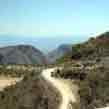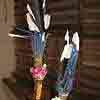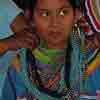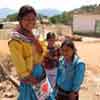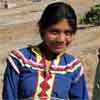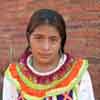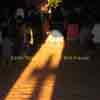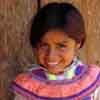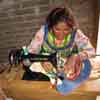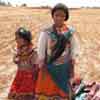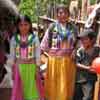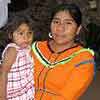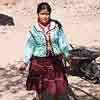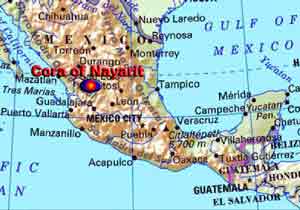 |
 |
 |
 |
|
The Cora, or Na'ayarij, people inhabit the rugged mountains and deep canyons of the Sierra del Nayar (a territory of around 5,000 square kms), part of the Sierra Madre Occidental. Most of the 16,410 Coras in Mexico (according to the 2000 census) live in Nayarit state (15,389 people). There are several Cora communities in the area of El Mezquital, Durango, and Coras also live across the Nayarit border in Jalisco. There are 5 major Cora communities in Nayarit -- Santa Teresa, Jesus Maria, San Pedro Ixcatán, San Juan Corapan, and Rosarito Saycota. Coras speak a Uto-Aztecan language; together with Huichol the two languages form the Corachol language family. Some linguists say the two major dialects of the Cora language are so different they might be considered separate languages. People have inhabited the Sierra del Nayar for at least 2,000 years. Spanish explorers first contacted the Coras in 1530. Attempts at conquest and conversion were violently repelled until 1722 when the Cora military leader Tlahuitole was captured and executed, and the Spanish destroyed Cora temples at Yauhke (Mesa del Nayar). Jesuits and then Franciscans established missions in Cora territory and began converting the Coras to Catholicism. In 1857 the Coras were part of an indigenous army that took control of much of Nayarit until the 1870's. The Coras rose up against the government again in 1926-1929 during the Cristero Rebellion. In the 1940's Mexico finally gained some measure of control over the Sierra del Nayar, establishing an administrative center in Jesus Maria. Coras are farmers who grow maize, beans, and squashes and other crops such as sugar cane, tomatoes and chiles as elevation and rainfall permit. Families also plant fruit trees and vegetable gardens. Families have ancestral rights to farm specific areas, although the land itself cannot be owned. Domestic animals like cattle and goats as well as turkeys, chickens and bees are kept. Most Coras live in isolated "ranchos" composed of related families with some families also owning houses in the ceremonial centers which they occupy during festivals. In the past Coras practiced polygyny, with a man marrying several sisters, but this practice is dying out. Part of economic life for many Cora men and boys is the annual winter migration to the plantations of the Nayarit coast to perform wage labor. Some Cora men have migrated to the western US to find work. Most Coras are Catholics, although Protestant conversions are taking place. Cora religion is a syncretic mix of Catholicism and indigenous beliefs in ancestor worship, shamanism, and animism. Deities such as the sun (Tayau), fire, and the morning star are venerated along with Jesus, Mary, and Catholic saints. Tobacco and peyote are used in religious contexts. The most important annual festival is "La Judea," the week-long Semana Santa (Holy Week) celebration in which hundreds of participants ("borrados") transform themselves into white and black demons, Moors, Pharisees, Jews, Christs, and other personages to carry out processions, battles and rituals. Cora men traditionally wore ankle-length white manta pants and colorful shirts along with leather huaraches, palm hats, and hand-woven shoulder bags. Many men now wear jeans, western-style shirts, cowboy hats, and other non-traditional clothing. The dress of women varies among communities, but generally women wear long, full skirts and elbow-length blouses of bright colored fabrics often decorated with ribbons and embroidery. Women also wear bead necklaces and earrings, wrap themselves in dark-patterned rebozos, and carry colorful hand-woven shoulder bags . |
||||||||||||||||||||||||||||||||||||||||||||||||||||||||||||||||||
